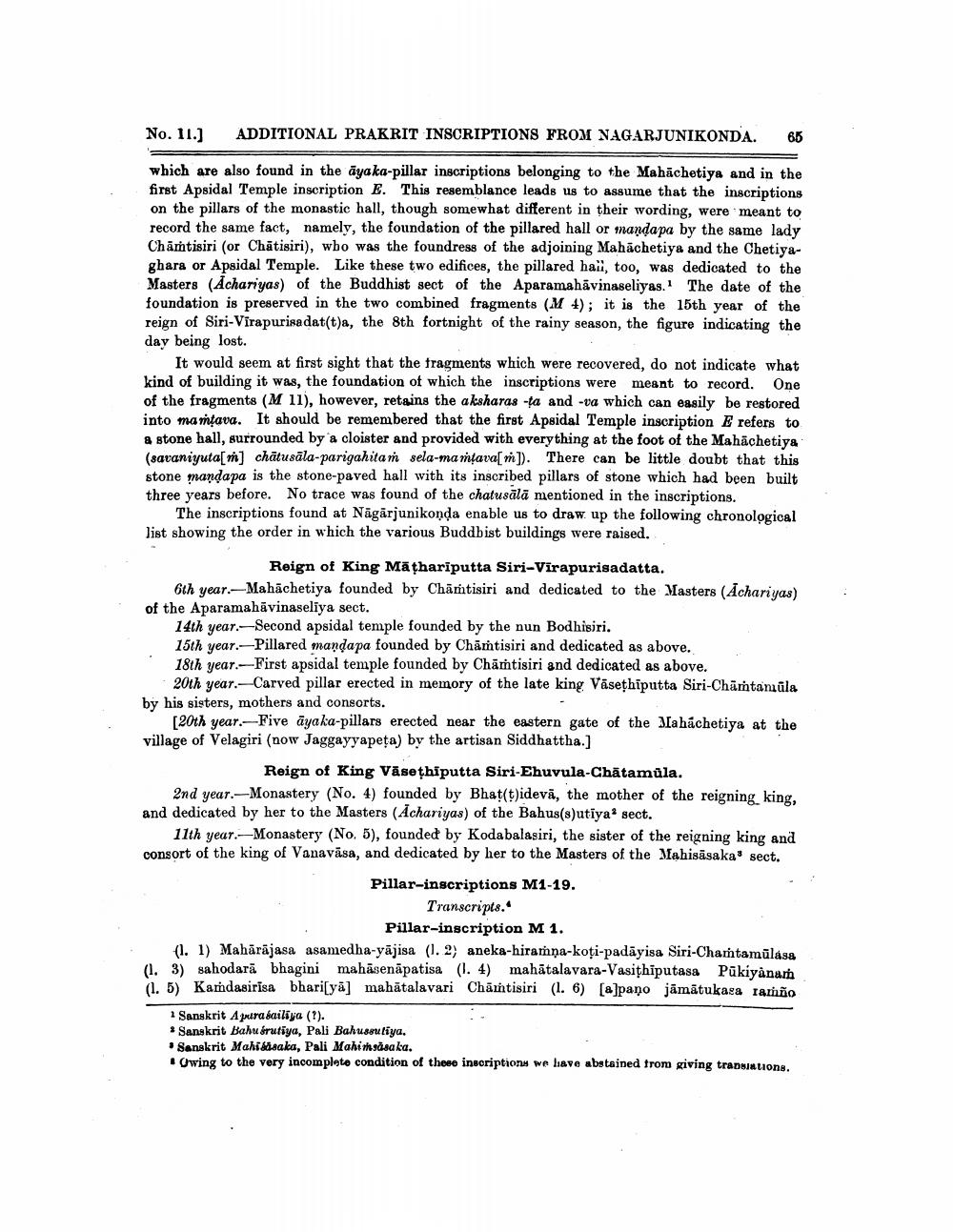________________
No. 11.]
ADDITIONAL PRAKRIT INSCRIPTIONS FROM NAGARJUNIKONDA.
which are also found in the ayaka-pillar inscriptions belonging to the Mahachetiya and in the first Apsidal Temple inscription E. This resemblance leads us to assume that the inscriptions on the pillars of the monastic hall, though somewhat different in their wording, were meant to record the same fact, namely, the foundation of the pillared hall or mandapa by the same lady Chamtisiri (or Chatisiri), who was the foundress of the adjoining Mahachetiya and the Chetiyaghara or Apsidal Temple. Like these two edifices, the pillared hail, too, was dedicated to the Masters (Achariyas) of the Buddhist sect of the Aparamahāvinaseliyas. The date of the foundation is preserved in the two combined fragments (M 4); it is the 15th year of the reign of Siri-Virapurisadat(t)a, the 8th fortnight of the rainy season, the figure indicating the day being lost.
65
It would seem at first sight that the fragments which were recovered, do not indicate what kind of building it was, the foundation of which the inscriptions were meant to record. One of the fragments (M 11), however, retains the aksharas ta and -va which can easily be restored into mamtava. It should be remembered that the first Apsidal Temple inscription E refers to a stone hall, surrounded by a cloister and provided with everything at the foot of the Mahachetiya (savaniyuta[m] chatusala-parigahitam sela-mamtava[m]). There can be little doubt that this stone mandapa is the stone-paved hall with its inscribed pillars of stone which had been built three years before. No trace was found of the chatusala mentioned in the inscriptions.
The inscriptions found at Nagarjunikonda enable us to draw up the following chronological list showing the order in which the various Buddhist buildings were raised.
Reign of King Maṭhariputta Siri-Virapurisadatta.
6th year. Mahachetiya founded by Chamtisiri and dedicated to the Masters (Achariyas) of the Aparamahāvinaselīya sect.
14th year. Second apsidal temple founded by the nun Bodhisiri.
Pillared mandapa founded by Chamtisiri and dedicated as above. First apsidal temple founded by Chamtisiri and dedicated as above.
15th year. 18th year. 20th year. Carved pillar erected in memory of the late king Vaseṭhiputta Siri-Chämtamula by his sisters, mothers and consorts.
[20th year. Five ayaka-pillars erected near the eastern gate of the Mahachetiya at the village of Velagiri (now Jaggayyapeta) by the artisan Siddhattha.]
Reign of King Vaseṭhiputta Siri-Ehuvula-Chātamula.
2nd year.-Monastery (No. 4) founded by Bhat(t)ideva, the mother of the reigning king, and dedicated by her to the Masters (Achariyas) of the Bahus(s)utiya' sect.
11th year. Monastery (No. 5), founded by Kodabalasiri, the sister of the reigning king and consort of the king of Vanavasa, and dedicated by her to the Masters of the Mahisāsaka sect.
Pillar-inscriptions M1-19.
Transcripts.
Pillar-inscription M 1.
(1.1) Mahārājasa asamedha-yajisa (1.2) aneka-hiramna-koti-padayisa Siri-Chamtamulása (1. 3) sahodara bhagini mahasenäpatisa (1. 4) mahatalavara-Vasiṭhiputasa Pukiyanam (1.5) Kamdasirisa bhari[ya] mahātalavari Chaitisiri (1. 6) [a]pano jāmātukasa ramño
1 Sanskrit Apura bailiya (?).
* Sanskrit Bahu érutiya, Pali Bahussuliya.
'Sanskrit Mahisasaka, Pali Mahimsasaka.
■ Owing to the very incomplete condition of these inscriptions we have abstained from giving translations.




